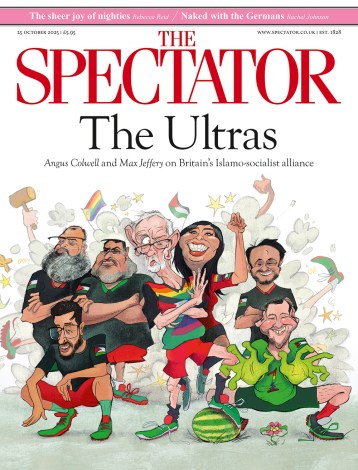
I am not I: thou art not he or she: they are not they.’ Few epigraphs to fiction have been so widely disregarded as the disclaimer with which Evelyn Waugh presaged Brideshead Revisited.
Immediately it was published, as Waugh’s great friend Nancy Mitford wrote to him, the general view was simply: ‘It is the Lygon family. Too much Catholic stuff.’ And it is easy to see why people were tempted to see Madresfield Court, seat of the Earl of Beauchamp, as the original of Brideshead.
Just as in Brideshead, here is a stiff older son and a younger son losing the golden beauty of his youth to alcoholism. Here were clever sisters, a starchy and religious materfamilias, and a father in exile following a scandal. And here — in Charles Ryder, just like Evelyn Waugh at Madresfield or ‘Mad’ — was a child of the middle classes bewitched by aristocracy, while watching it go to ruin.
Paula Byrne’s book is not, as she explains in her introduction, a full biography of Waugh. If it is a biography of anything, it is a biography of Brideshead Revisited — and the complex of memory and feeling from which it arose. It takes in the by now familiar brew of Oxford homosexuality, Catholic theology, class anxiety, architectural nostalgia and heavy, heavy drinking.
But it sets out to concentrate on how all these arose from, and played into, Waugh’s infatuated friendship with the Lygon family: from a probable romance at Oxford with the second son, Hugh; through spectacular jazz-age parties at Madresfield; to decades-long correspondence with his sisters Mary (Maimie, or Blondy) and Dorothy (Coote).
The Waugh who emerges in Byrne’s book is a more sympathetic one than you sometimes get: of course, incredibly funny; but also a loyal and kind friend and someone blessed, or cursed, with self-knowledge of particular astringency. He was a man of remarkable physical courage, too: his adventures with Hugh Lygon in the Arctic circle are a startling corrective to the familiar image of the portly, owlish clubman upholstered in tweed.
There is new stuff here, too, and Byrne’s tenacity and precision are welcome. Without saying how she achieved it, for instance, she modestly points out a scoop in a footnote. The Beauchamp divorce petition — a lively catalogue of sodomy, fellatio and intercrural sex with several named servants — was supposed to have been sealed until 2032, but ‘the closure has been cancelled and the document has been released to me for the first time by the National Archives at Kew’.
The story of ‘Boom’ Beauchamp’s downfall and exile is a corker. His brother-in-law, the vile Duke of Westminster, had him followed by private detectives and did everything he could to see him arrested and publicly disgraced. What’s really touching, though, is how most of the children took his side against his mother. Hugh talked him out of committing suicide; his daughters wrote to him constantly as he roamed the world buggering his ‘valet’ and ogling Australian lifeguards and Venetian stevedores.
Boom sounds a highly sympathetic character — amusing, erudite, civilised, a fabulous host, and a dab hand at needlepoint and, in later life, knitting. Lady Beauchamp was a frightful bag, on the other hand: described by one daughter as ‘very odd, a religious zealot’, she was known as ‘Tomo’, after her motto ‘Tidiness, Order, Method and Organisation’.
When as a child her eldest daughter Sibell — fed up with swimming in the icy sea — asked to be let off bathing as her birthday treat, she was forced to go in twice. When she complained of being stung by a jellyfish, ‘Mother’s cure for that was to fill a bucket with jellyfish and throw them at me.’ After Boom departed, the children removed her bust from Madresfield and threw it in the moat.
An irresistibly strange cameo, incidentally, brings the late Barbara Cartland into the picture. Those of us who remember that great pink powder-puff of a woman, boasting of how many proposals of marriage she collected as a girl, will be surprised to learn that she was in love with and ‘desperate to marry’ Lord Elmley (Beauchamp’s heir): ‘Elmley did not reciprocate the affection, though he did take Miss Cartland’s virginity.’
Elsewhere Byrne patiently pieces together what can be found out about Waugh’s little-known trip to Rome in 1932 to be confirmed by Cardinal Lepicier; and you mark with admiration her attentiveness to the versions of texts, carefully reinstating sentences redacted from published letters, and lucidly explaining the revisions made in manuscript and published versions of the novels.
Her judgments, too, are persuasive: and rather than insist on a one-to-one correspondence between fictional characters and their originals, she argues that Waugh tended to mash two characters into one — both Harold Acton and Brian Howard went into Anthony Blanche, for instance, with Waugh altering the blend as he revised the text.
The purpose of this book is not to insist that Brideshead is a roman-a-clef — but Byrne makes a very plausible case for the value of seeking the roots of Waugh’s imagination in his life. After all, as Waugh started work on Brideshead he originally conceived it as a wholly private project rather than a novel for publication.
As Byrne puts it at one point, writing about Vile Bodies (Byrne judges A Handful of Dust Waugh’s masterpiece, incidentally, rather than Brideshead): ‘Waugh was perfecting the art of simultaneously laying out a moral vision and turning his private quarrels into art.’
Byrne’s coda to the story is a poignant one: Coote forging off stoically into apparent spinsterhood; Boom and Hugh gone; the Earldom on its way to extinction; Maimie descending — like so many of those bright things — into alcoholism and madness.
‘Darling,’ she wrote to Waugh in August 1954 after being hospitalised, ‘What are the saddest words in the English language — If Only, Never Again, Kept Waiting, Too Late, No Answer, Just Because. I think If Only is the Saddest.’
Also sad — sadder for reading this book — are the words: ‘I am not I: thou art not he or she: they are not they.’






Comments